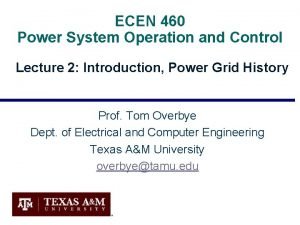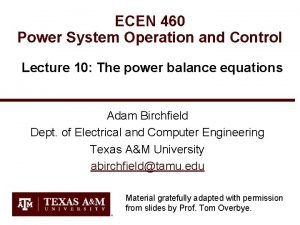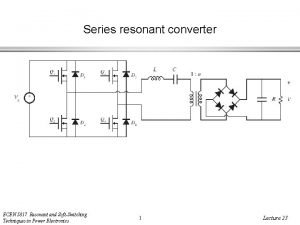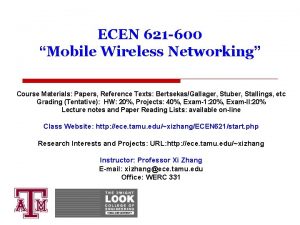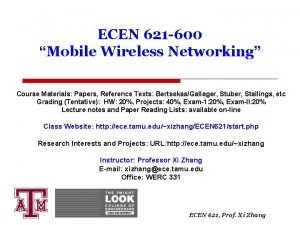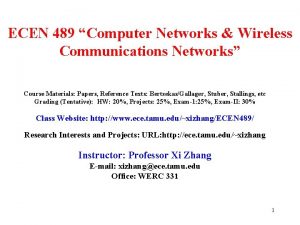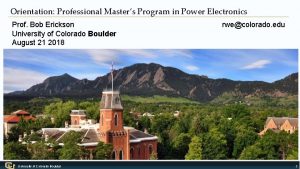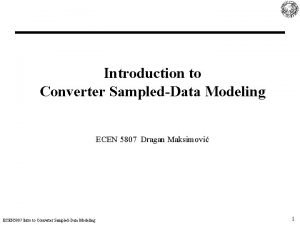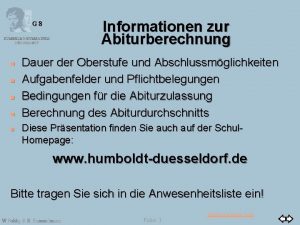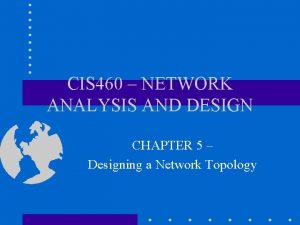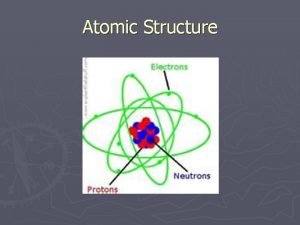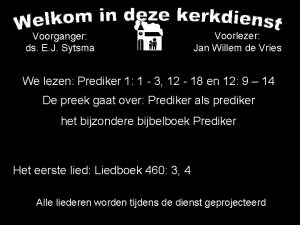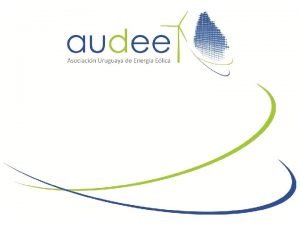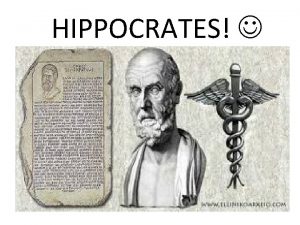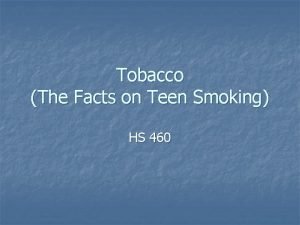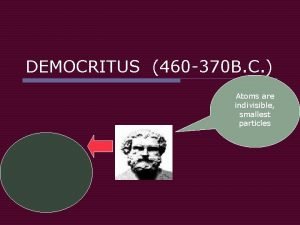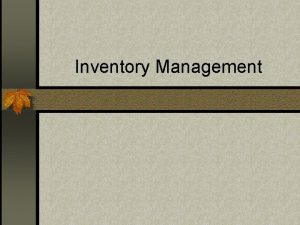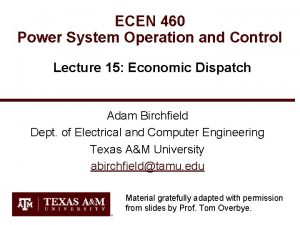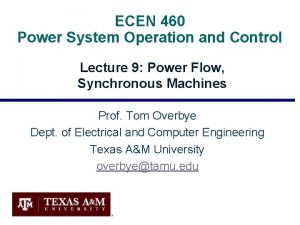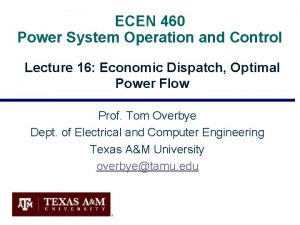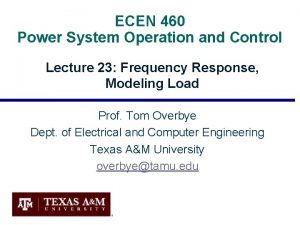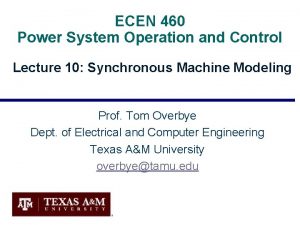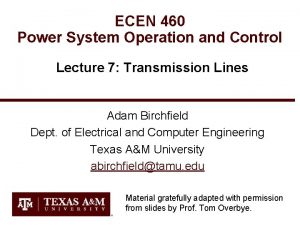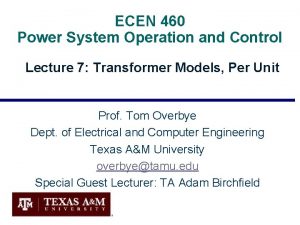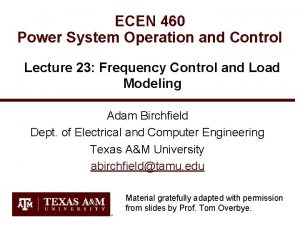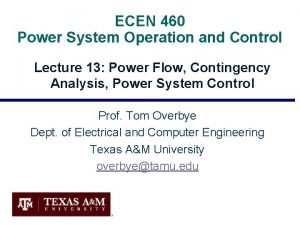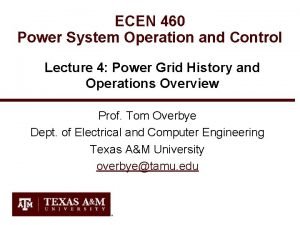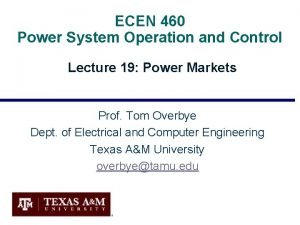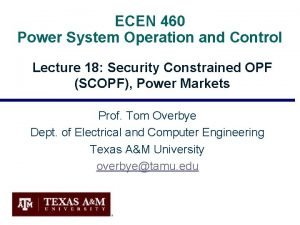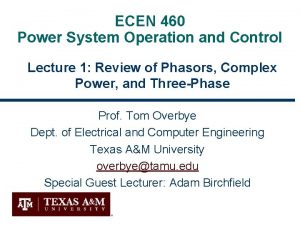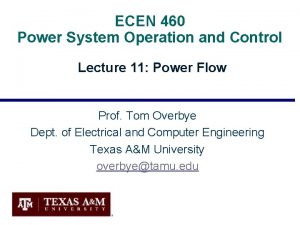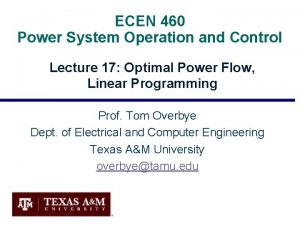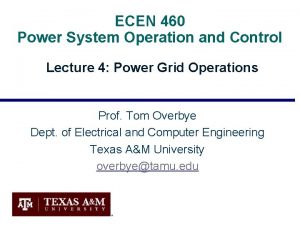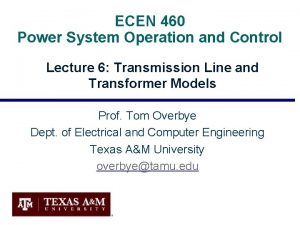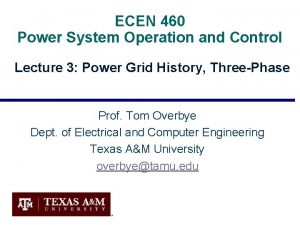ECEN 460 Power System Operation and Control Lecture































- Slides: 31

ECEN 460 Power System Operation and Control Lecture 24: Modeling Load, Renewable Energy Systems Prof. Tom Overbye Dept. of Electrical and Computer Engineering Texas A&M University overbye@tamu. edu

Announcements • Read Chapter 14 • Design project is due on Dec 5; details on the website – Counts as two homeworks • Homework 8 is 11. 12, 11. 18 (part a only), 11. 19, 11. 25, 11. 26; due today 11. 21 was removed on Tuesday • No labs week of Dec 4 • Final exam is as per the TAMU schedule, Wednesday Dec 13 from 8 to 10 am – – Closed book, closed notes; calculators and three 8. 5 by 11 inch note sheets allowed (front and back) Comprehensive with more emphasis on material after exam 2 1

Induction Motor Classes • Four major classes of induction motors, based on application. Key values are starting torque, pull-out torque, full-load torque, and starting current In steady-state the motor will operate on the right side of the curve at the point at which the electrical torque matches the mechanical torque A: Fans, pumps machine tools B: Similar to A C: Compressors, conveyors D: High inertia such as hoists Image source: ecmweb. com/motors/understanding-induction-motor-nameplate-information 2

Induction Motor Stalling • The maximum of the torque-speed curve varies with the square of the terminal voltage • When the terminal voltage decreases, such as during a fault, the mechanical torque can exceed the electrical torque – – – This causes the motor to decelerate, perhaps quite quickly, with the rate proportional to its inertia This deceleration causing the slip to increase, perhaps causing the motor to stall with s=1, resulting in a high reactive current draw Too many stalled motors can prevent the voltage from recovering 3

Motor Stalling Example • Using case WSCC_CIM 5, which models the WSCC 9 bus case with 100% induction motor load • Change the fault scenario to say a fault midway between buses 5 and 7, cleared by opening the line Results are for a 0. 1 second fault Usually motor load is much less than 100% 4

Composite Load Model • Contains up to four motors or single phase induction motor models; also includes potential for solar PV 5

Modeling Time Variation in Load • Different time varying composite model parameters are now being used Example of varying composite load percentages over a day 6

Motor Starting • Motor starting analysis looks at the impacts of starting a motor or a series of motors (usually quite large motors) on the power grid – Examples are new load or black start plans • While not all transient stability motor load models allow the motor to start, some do • When energized, the initial condition for the motor is slip of 1. 0 • Motor starting can generate very small time constants 7

Motor Starting Example • Below graph shows the bus voltages for starting the four motors three seconds apart 8

Black Start • A black start is the process of restoring an electric grid following the outage of the entire grid • Key issue is large generators require substantial amounts electric load to start (station service); this would not be available following a blackout • Each utility would have a detailed process. An example is – – – Have batteries to start a diesel generator Use that to start a hydro plant (which doesn’t require much power to start) Sequentially connect transmission lines to larger plants, making sure grid has enough capacity to start these plants 9

Renewable Resource Modeling • With the advent of more renewable generation in power systems worldwide it is important to have correct models • Hydro systems have already been covered • Solar thermal and geothermal are modeled similar to existing stream generation, so they are not covered here • Coverage will focus on wind and solar PV for integrated system studies – Models are evolving, with a desire by many to have as generic as possible models 10

Growth in Wind Worldwide Source: Global Wind 2016 Report, Global Wind Energy Council 11

Growth in Wind Worldwide Source: Global Wind 2016 Report, Global Wind Energy Council 12

Vestas Wind Systems Stock Price • Vestas’s stock has increased by more than 15 times from their 2012/2013 lows! Their price fell significantly in November due to increased competition in wind power markets 13

Growth in US Wind • Production tax credit of $24/MWh being phased out – 100% in 2016, 80% in 2017, 60% in 2018, 40% in 2019 Source: American Wind Energy Association 2017 Third Quarter Market Report 14

2016 Installed Capacity by State: Texas Continues to Dominate! Source: American Wind Energy Association 2017 Third Quarter Market Report 15

Wind Farm and Wind-Related Plant Locations http: //gis. awea. org/arcgisportal/apps/webappviewer/index. html? id=eed 1 ec 3 b 624742 f 8 b 18280 e 6 aa 73 e 8 ec 16

State Renewable Portfolio Standards Texas has a goal of 10 GW by 2025, but that has already been achieved (by more than double!) Image source: dsireusa. org (see for updated information) 17

US Wind Resources Source: http: //www. windpoweringamerica. gov/wind_maps. asp 18

Global Wind Speed 50 m Map http: //www. climate-charts. com/World-Climate-Maps. html#wind-speed 19

Wind Map Texas– 80 m Height https: //windexchange. energy. gov/files/u/visualization/image/tx_80 m. jpg 20

Power in the Wind • The power in the wind is proportional to the cube of the wind speed – Velocity increases with height, with more increase over rougher terrain (doubling at 100 m compared to 10 m for a small town, but only increasing by 60% over crops or 30% over calm water) • Maximum rotor efficiency is 59. 3%, from Betz' law • Expected available energy depends on the wind speed probability density function (pdf) 21

Wind Turbine Height and Size The current largest wind turbine by capacity is the Vestas V 164 which has a capacity of 8 MW, a height of 220 m, and diameter of 164 m. Source: cdn. arstechnica. net/wp-content/uploads/2016/11/6 e 9 cb 9 fc-0 c 18 -46 db-9176 -883 cbb 08 eace. png 22

Extracted Power • WTGs are designed for rated power and windspeed – For speeds above this blades are pitched to operate at rated power; at furling speed the WTG is cut out 23

Example: GE 1. 5 and 1. 6 MW Turbines • Power speed curves for the GE 1. 5 and 1. 6 MW WTGs – Hub height is 80/100 m; cut-out at 25 m/s wind Source: http: //site. ge-energy. com/prod_serv/products/wind_turbines/en/15 mw/index. htm 24

Wind Farms (or Parks) • Usually wind farm is modeled in aggregate for grid studies; wind farm can consist of many small (1 to 3 MW) wind turbine-generators (WTGs) operating at low voltage (e. g. 0. 6 k. V) stepped up to distribution level (e. g. , 34. 5 k. V) Photo Source: www. energyindustryphotos. com/photos_of_wind_farm_turbines. htm 25

Economies of Scale • Presently large wind farms produce electricity more economically than small operations • Factors that contribute to lower costs are – – Wind power is proportional to the area covered by the blade (square of diameter) while tower costs vary with a value less than the square of the diameter Larger blades are higher, permitting access to faster winds, but size limited by transportation for most land wind farms Fixed costs associated with construction (permitting, management) are spread over more MWs of capacity Efficiencies in managing larger wind farms typically result in lower O&M costs (on-site staff reduces travel costs) 26

Wind Energy Economics • Most of the cost is in the initial purchase and construction (capital costs); current estimate is about $1690/k. W; how much wind is generated depends on the capacity factor, best is about 40% Source: www. awea. org/falling-wind-energy-costs 27

Environmental Aspects of Wind Energy • US National Academies issued report on issue in 2007 • Wind system emit no air pollution and no carbon dioxide; they also have essentially no water requirements • Wind energy serves to displace the production of energy from other sources (usually fossil fuels) resulting in a net decrease in pollution • Other impacts of wind energy are on animals, primarily birds and bats, and on humans 28

Environmental Aspects of Wind Energy, Birds and Bats • Wind turbines certainly kill birds and bats, but so do lots of other things; cats kill hundreds of millions of birds in North America, and windows do in about 100 million Source: Avian and Conservation Ecology Journal, 2013, Canada data; www. ace-eco. org/vol 8/iss 2/art 11/ 29

Environmental Aspects of Wind Energy, Birds and Bats • Of course most people do not equate killing a little bird, like a sparrow, the same as killing a bigger bird, like an eagle (less prone to hit windows or die by the cat). – Large bird (raptor) mortalities are about 0. 04 bird/MW/year, but these values vary substantially by location with Altamont Pass (CA) killing about 1 raptor/MW/year. • Turbine design and location has a large impact on mortality – – – Ideally sited on already “altered” habitats like farmland; not by migratory bottlenecks, or by endangered species areas Use nighttime lighting that avoids collisions, like strobe lights Buried transmission lines 30
 Ecen 460
Ecen 460 Ecen 460
Ecen 460 Ecen 5817
Ecen 5817 Ecen 621
Ecen 621 Ecen 621
Ecen 621 Ecen 621
Ecen 621 Ecen 489
Ecen 489 Ecen 5797
Ecen 5797 Ecen 5807
Ecen 5807 Power system dynamics and stability lecture notes
Power system dynamics and stability lecture notes Power system dynamics and stability lecture notes
Power system dynamics and stability lecture notes Zline 667-36
Zline 667-36 01:640:244 lecture notes - lecture 15: plat, idah, farad
01:640:244 lecture notes - lecture 15: plat, idah, farad Real power and reactive power
Real power and reactive power Democritus theory of the universe
Democritus theory of the universe Apnak bang
Apnak bang 460 punkte abitur
460 punkte abitur Cadillac escalade rental houston
Cadillac escalade rental houston Cis460
Cis460 What scientist discovered the electron
What scientist discovered the electron Gezang 179
Gezang 179 Who discovered roentgenograms
Who discovered roentgenograms Yüzlüğe yuvarlama hesap makinesi
Yüzlüğe yuvarlama hesap makinesi Sen 460
Sen 460 Multis complex shd 460
Multis complex shd 460 St 460 ts
St 460 ts Hippocrates biography
Hippocrates biography Hs 460
Hs 460 Democritus 460 bc
Democritus 460 bc Introduction to inventory management
Introduction to inventory management Power angle curve in power system stability
Power angle curve in power system stability Power semiconductor devices lecture notes
Power semiconductor devices lecture notes
